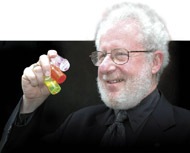|
by Tan Lay Leng

 rofessor Alan J Heeger, Nobel laureate in Chemistry in 2000, believes that materials will be an inseparable part of life sciences in the future. He is now weaving biology into his polymer research, in particular his newly-developed semiconducting polymers. One novel application is making the luminescent polymers "shine the light" on certain biological molecules. rofessor Alan J Heeger, Nobel laureate in Chemistry in 2000, believes that materials will be an inseparable part of life sciences in the future. He is now weaving biology into his polymer research, in particular his newly-developed semiconducting polymers. One novel application is making the luminescent polymers "shine the light" on certain biological molecules.
Heeger currently focuses on using semiconductor polymers to design biosensors. He is working with QTL Biosystems' Dr Duncan McBranch and David Whitten to make luminescent water-soluble polymers that emit light in the presence of specific biological molecules.
The researchers based the patent-pending technology on a simple lock-and-key approach to selective identification of biological molecules. The "key" portion of this invention consists of a tailor-made molecule comprising three principal components: Quencher/Tether/Ligand (QTL). The biological molecule under investigation represents the "lock," which binds to the biologically selective ligand portion. The tether connects the ligand to the quencher. This complex will bind weakly with the fluorescent polymer, quenching or "turning off" the light emitted from the polymer.
The quenching can be reversed if recognition of a biological molecule at a receptor site causes strong binding between the receptor and the ligand. For instance, the scientists can use an antibody as the ligand in the QTL molecule to detect its specific antigen. When the antigen (lock) associated with this antibody binds to the ligand site, it pulls the quencher away from the fluorescent polymer and the solution lights up.
Thus researchers can develop a very sensitive biosensor that is biospecific because it is built upon the antibody-antigen molecular-recognition principle. This has exciting possibilities since the ligand, which is biospecific, can be changed according to the biomolecule under investigation.
The researchers have demonstrated that a single quencher can quench an entire macromolecule. As a result, this concept promises biosensors that exhibit high sensitivity. "We see semiconducting polymers as potentially useful in homogeneous assays, and we're hopeful that we can develop the concept into a wide class of very rapid response sensors," Heeger comments. However, he also concedes that this totally new approach remains at an early stage.
This physics professor from the University of California at Santa Barbara straddles his two jobs as an academic and a technopreneur comfortably. Besides serving as a director on QTL Biosystems' board and a scientific advisor, Heeger also involves himself as a co-founder of Uniax Corp, a company started to produce polymer devices and acquired by Du Pont Corp last year. As a chief scientist, he works on next-generation technology and application of these materials. The first products will be small monochromatic single-colored displays, expected to be available next year. Plans exist for multicolored plastic substrates and then the whole field of plastic electronics beyond displays: photodetectors, solar cells, plastic transistors - the list goes on.
Heeger finds academia and industry equally compelling, having been exposed to both sides of the coin. He notes that the main difference between the two sides lies in the university's working in science as a principal goal. From that work, possibilities of applications sometimes arise. Companies, on the other hand, focus quite closely on research and development that leads to products and applications. However, he stresses the importance of basic science because "once you make those basic discoveries, you can try to develop a technology, then inventions can come more quickly." The invention process can be "forced" or accelerated by hard work.
Heeger works with various groups all over Asia, including the Institute of Materials Research and Engineering in Singapore. He finds the quality of researchers in this region very high and has greatly benefited from his interaction with his collaborators here.
With scientists here of world-class quality, why then doesn't Asia produce more significant breakthroughs? And why does the United States lead the worldwide research community?
Heeger attributes this difference largely to a climate of risk taking. "In American culture, risk taking is accepted, even encouraged," and society inculcates this attitude in the young. He feels that in some cultures, including the Asian cultures, people hesitate to take risks. "When you want to go off in a new direction in science, it's a big risk for the scientist because it might end up with nothing of value, or it might take you to a dead end. But if you really want to create something new, you have to go and take those risks."
His advice to those contemplating research as a career: "Go for it, it's fun. You can enjoy yourself, you can make a living, you can work hard, and you can create new things. A wonderful opportunity exists there to dedicate yourself."
|



 rofessor Alan J Heeger, Nobel laureate in Chemistry in 2000, believes that materials will be an inseparable part of life sciences in the future. He is now weaving biology into his polymer research, in particular his newly-developed semiconducting polymers. One novel application is making the luminescent polymers "shine the light" on certain biological molecules.
rofessor Alan J Heeger, Nobel laureate in Chemistry in 2000, believes that materials will be an inseparable part of life sciences in the future. He is now weaving biology into his polymer research, in particular his newly-developed semiconducting polymers. One novel application is making the luminescent polymers "shine the light" on certain biological molecules.